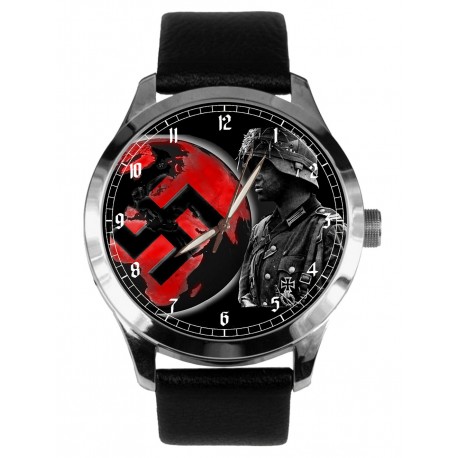Home
Top sellers
-

WW2 Germany SS Tank Commander Military Skull Art Solid Brass Wrist Watch
Premium Citizen 2040 quartz movement. 40 mm large size heavy brass...
$143.65 -

Gauleiter / SS. Nazi Germany WW-II Art Print Collectible 40 mm Wrist Watch
40 mm heavy brass case, genuine leather strap, quartz movement
$143.65 -

-

-

WW-II Messerschmitt Bf110 Luftwaffe Art Retro 40 mm Chromed Brass Aviator Wrist Watch
Premium Citizen 2040 quartz movement. 40 mm large size heavy brass...
$143.65 -

Waffen SS Nazi Germany WW-II Recruitment Poster Art Solid Brass 40 mm Wrist Watch
40 mm heavy brass case, genuine leather strap, quartz movement
$143.65 -

WW-II Germany Luftwaffe FW-190A FOCKE WULF Collectible Aviation Art Wrist Watch
Premium Citizen 2040 quartz movement. 40 mm large size heavy brass...
$143.65 -

Authentic German WW-II Kriegsmarine Push-Button Heavy Brass Compass
1.75 inches solid brass, German language compass rose with deeply...
$143.65 -

Donald Trump as Hitler. Nazi-themed Anti Trump Collectible Wrist Watch
Premium Citizen 2040 quartz movement. 40 mm large size heavy brass...
$143.65 -

Adolf Hitler Wrist Watch German Nationalism. Deutschen Nationalismus Armbanduhr
Premium Citizen 2040 quartz movement. 40 mm large size heavy brass...
$143.65
Nazi SS WW-II Germany World Domination Violent Red Black Colours Swastika Art 40 mm Solid Brass Wrist Watch
COM-WD1
New product
- large format 40 mm solid brass casing with stainless steel back
- premium 2040 quartz movement, easily to replace regular watch batteries.
- original parchment art metal on acrylic dial
- 1 year warranty
- Classic pinewood presentation / keepsake pillowed box
More info
New Order (Nazism)
The New Order (German: Neuordnung) of Europe was the political order which Nazi Germany wanted to impose on the conquered areas under its dominion. The establishment of the Neuordnung had already begun long before the start of World War II, but was publicly proclaimed by Adolf Hitler in 1941: "The year 1941 will be, I am convinced, the historical year of a great European New Order!"
Among other things, it entailed the creation of a pan-German racial state, structured according to Nazi ideology, to ensure the existence of a perceived Aryan-Nordic master race, consolidate a massive territorial expansion into Central and Eastern Europe through colonization by German settlers, achieve the physical annihilation of Jews, Slavs (especially Poles and Russians), Roma ("gypsies"), and others considered to be "unworthy of life", as well as the extermination, expulsion or enslavement of most of the Slavic peoples and others regarded as "racially inferior".[2] Nazi Germany's desire for aggressive territorial expansionism was one of the most important causes of World War II.
Historians are still divided as to its ultimate goals, some believing that it was to be limited to Nazi German domination of Europe, while others maintain that it was a springboard for eventual world conquest and the establishment of a world government under German control.[3]
The Führer gave expression to his unshakable conviction that the Reich will be the master of all Europe. We shall yet have to engage in many fights, but these will undoubtedly lead to most wonderful victories. From there on the way to world domination is practically certain. Whoever dominates Europe will thereby assume the leadership of the world.
— Joseph Goebbels, Reich Minister of Propaganda, 8 May 1943
Origin of the term
The term Neuordnung originally had a more limited meaning than it did later. It is typically translated as "New Order", but a more correct translation would be more akin to "reorganization".[citation needed] When it was used in Germany during the Third Reich era, it referred specifically to the desire of the Nazis to redraw the state borders within Europe, thereby transforming the existing geopolitical structures. In the same sense, it has also been used, now and in the past, to denote similar re-orderings of the international political order such as those following the Peace of Westphalia in 1648, the Vienna Congress in 1815, and the Allied victory in 1945. The complete phrase used by the Nazi establishment was actually die Neuordnung Europas (the New Order of Europe), for which Neuordnung was merely a shorthand.
According to the Nazi government, that principle was pursued by Germany to secure a fair rearrangement of territory for the common benefit of a new, economically integrated Europe,[5] which in Nazi terminology meant the continent of Europe with the exception of the "Asiatic" Soviet Union.[6] Nazi racial views regarded the "Judeo-Bolshevist" Soviet state as both a criminal institution which needed to be destroyed, and as a barbarian place lacking any culture that would give it a "European" character.[7] Therefore, Neuordnung was rarely used in reference to Soviet Russia, because the Nazis believed it did not feature any elements that could be re-organized along National Socialist lines.
The objective was to ensure a state of total post-war continental hegemony for Nazi Germany.[8] That was to be achieved by the expansion of the territorial base of the German state itself, combined with the political and economic subjugation of the rest of Europe to Germany. Eventual extensions of the project to areas beyond Europe, as well as on an ultimately global scale, were anticipated for the future period in which Germany would have secured unchallenged control over her own continent, but Neuordnung did not carry that extra-European meaning at the time.
Through its wide use in Nazi propaganda, the phrase quickly gained coinage in Western media. In English-language academic circles especially, it eventually carried a much more inclusive definition, and was increasingly used to refer to the foreign and domestic policies, and the war aims, of the Nazi state, and its dictatorial leader Adolf Hitler. Therefore, the phrase had approximately the same connotations as the term co-prosperity sphere did in Japanese circles, in reference to their planned imperial domain. Nowadays, it is generally used to refer to all the post-war plans and policies, both in and outside of Europe, that the Nazis expected to implement after the anticipated victory of Germany and the other Axis powers in World War II.
Ideological background
Racialist doctrine
The Nazis claimed to scientifically measure a strict hierarchy of human race. The "master race" was said to comprise the purest stock of the Aryan race, which was narrowly defined by the Nazis as being identical with the Nordic race, followed by other sub-Aryan races. The Nazis said that because Western civilization, created and maintained mostly by Nordics, was obviously superior to other civilizations, the "Nordic" peoples were superior to all other races and were entitled to dominate the world, a concept known as Nordicism.
Geopolitical strategy
Hitler’s ideas about eastward expansion that he promulgated in Mein Kampf were greatly influenced during his 1924 imprisonment by his contact with his geopolitical mentor Karl Haushofer.[11] One of Haushofer’s primary geopolitical concepts was the necessity for Germany to get control of the Eurasian Heartland in order for it to attain eventual world domination.
Anticipated territorial extent of Nazi imperialism
In a subsequently published speech given at Erlangen University in November 1930, Hitler explained to his audience that no other people had more of a right to fight for and attain "control" of the globe (Weltherrschaft, i.e. "world leadership", "world rule") than the Germans. He realized that extremely ambitious goal could never be achieved without significant military effort.[13] Hitler had alluded to future German world dominance even earlier in his political career. In a letter written by Rudolf Hess to Walter Hewel in 1927, Hess paraphrases Hitler's vision: "World peace is certainly an ideal worth striving for; in Hitler's opinion it will be realizable only when one power, the racially best one, has attained complete and uncontested supremacy. That [power] can then provide a sort of world police, seeing to it at the same time that the most valuable race is guaranteed the necessary living space. And if no other way is open to them, the lower races will have to restrict themselves accordingly".[14]
Heinrich Himmler discussed the territorial aspirations of Germany during his first Posen speech in 1943. He commented on the goals of the warring nations involved in the conflict, and stated that Germany was fighting for new territories and a global power status:[15]
[T]he Seven Years' War brought Prussia's confirmation as a great European power. That war was carried on for seven years to ensure that the already conquered province of Silesia would remain part of Prussia. This war will ensure that everything annexed to the German Reich, to Greater Germany, and then to the Germanic Reich in the years since 1938, will remain ours. This war is being carried on to keep the path to the East open; so that Germany may be a world power; to found the Germanic World Empire (Germanisches Weltreich).
Implementation in Europe
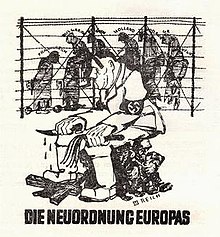
Military campaigns in Poland and Western Europe
The initial phase of the establishment of the New Order was:
- First, the signing of the German–Soviet non-aggression agreement on 23 August 1939 prior to the invasion of Poland to secure the new eastern border with the Soviet Union, prevent the emergence of a two-front war, and to circumvent a shortage of raw materials due to an expected British naval blockade.
- Second, the Blitzkrieg attacks in northern and western Europe (Operation Weserübung and the Battle of France respectively) to neutralize opposition from the west. This resulted in the conquest of Denmark, Norway, Luxembourg, Belgium, the Netherlands, and France, all of which were under German rule by the early summer of 1940.
Had the British been defeated by Germany, the political re-ordering of Western Europe would have been accomplished. There was to be no post-war general peace conference in the manner of the one held in Paris after the First World War, merely bilateral negotiations between Germany and her defeated enemies.[16] All still existing international organizations such as the International Labour Organization were to be dismantled or replaced by German-controlled equivalents.
One of the primary German foreign policy aims throughout the 1930s had been to establish a military alliance with the United Kingdom, and despite anti-British policies having been adopted as this proved impossible, hope remained that the UK would in time yet become a reliable German ally.[17] Hitler professed an admiration for the British Empire and preferred to see it preserved as a world power, mostly because its break-up would benefit other countries far more than it would Germany, particularly the United States and Japan.[17][18] Britain's situation was likened to the historical situation of the Austrian Empire after its defeat by the Kingdom of Prussia in 1866, after which Austria was formally excluded from German affairs but would prove to become a loyal ally of the German Empire in the pre-World War I power alignments in Europe. It was hoped that a defeated Britain would fulfill a similar role, being excluded from continental affairs, but maintaining its Empire and becoming an allied seafaring partner of the Germans.[19][17]
William L. Shirer, however, claims that the British male population between 17 and 45 would have been forcibly transferred to the continent to be used as industrial slave labour, although possibly with better treatment than similar forced labor from Eastern Europe.[20] The remaining population would have been terrorized, including civilian hostages being taken and the death penalty immediately imposed for even the most trivial acts of resistance, with the UK being plundered for anything of financial, military, industrial or cultural value.[21]
After the war, Otto Bräutigam of the Reich Ministry for the Occupied Eastern Territories claimed in his book that in February 1943 he had the opportunity to read a personal report by Wagner regarding a discussion with Heinrich Himmler, in which Himmler had expressed the intention to exterminate about 80% of the populations of France and England by special forces of the SD after the German victory.[22][page needed]
By annexing large territories in northeastern France, Hitler hoped to marginalize the country to prevent any further continental challenges to Germany's hegemony.[23] Likewise, the Latin nations of Western and Southern Europe (Portugal, Spain and Italy) were to be eventually brought into a state of total German dependency and control.[23]
Establishment of a Greater Germanic Reich
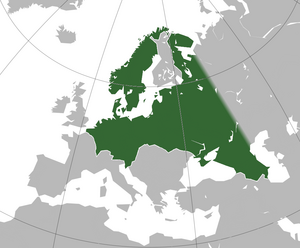
One of the most elaborate Nazi projects initiated in the newly conquered territories during this period of the war was the planned establishment of a "Greater Germanic Reich of the German Nation" (Großgermanisches Reich Deutscher Nation).[25] This future empire was to consist of, in addition to Greater Germany, virtually all of historically Germanic Europe (except Great Britain), whose inhabitants the Nazis believed to be "Aryan" in nature. The consolidation of these countries as mere provinces of the Third Reich, in the same manner in which Austria was reduced to the "Ostmark", was to be carried out through a rapidly enforced process of Gleichschaltung (synchronization). The ultimate intent of this was to eradicate all traces of national rather than racial consciousness, although their native languages were to remain in existence.[26][27]
Establishment of German domination in Southeastern Europe
Immediately prior to Germany's invasion of the Soviet Union, five countries, Slovakia, Hungary, Romania, Bulgaria and Croatia were already client states of Nazi Germany. Serbia was under direct German military occupation and Montenegro was under occupation of Italy. Albania had been annexed by Italy[citation needed]. Greece was under direct German-Italian military occupation because of the growing resistance movement. Although technically in the Italian sphere of influence, Croatia was in reality a condominium puppet state of the two Axis powers, with Italy controlling the southwestern half, and Germany the northeastern half. Hitler observed that permanent German bases might be established in Belgrade (possibly to be renamed to Prinz-Eugen-Stadt) and Thessaloniki.[28]
Conquest of Lebensraum in Eastern Europe
And so we National Socialists consciously draw a line beneath the foreign policy tendency of our pre-War period. We take up where we broke off six hundred years ago. We stop the endless German movement to the south and west, and turn our gaze toward the land in the east. At long last we break off the colonial and commercial policy of the pre-War period and shift to the soil policy of the future. If we speak of soil in Europe today, we can primarily have in mind only Russia and her vassal border states.
— Adolf Hitler in Mein Kampf on Lebensraum in the East.[29]
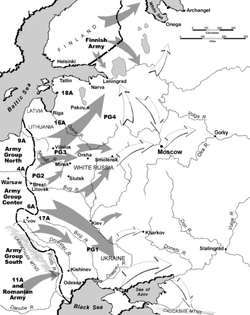
Adolf Hitler in Mein Kampf argued in the chapter "Eastern Orientation or Eastern Policy" that the Germans needed Lebensraum in the East and described it as a "historic destiny" which would properly nurture the future generations of Germans. Hitler believed that "the organization of a Russian state formation was not the result of the political abilities of the Slavs in Russia, but only a wonderful example of the state-forming efficacity of the German element in an inferior race." Hitler spoke on 3 February 1933 to the staff of the army and declared that Germany's problems could be solved by "the conquest of new living space in the east and its ruthless Germanization".[30] His earlier invasions of Czechoslovakia and Poland can be directly connected to his desire for Lebensraum in Mein Kampf.
Implementation of the long term plan for the New Order was begun on June 22, 1941 with Operation Barbarossa, the invasion of the USSR. The goal of the campaign was not merely the destruction of the Soviet regime—which the Nazis considered illegitimate and criminal—but also the racial reorganization of European Russia, outlined for the Nazi elite in the Generalplan Ost ("General Plan for the East").[31] Nazi party philosopher Alfred Rosenberg (who, incidentally, protested against the inhumane policy shown toward the Slavs[32]) was the Minister for the Eastern Territories, the person nominally in charge of the project, and Heinrich Himmler, head of the SS, was assigned to implement the General Plan for the East which detailed the enslavement, expulsion, and extermination of the Baltic peoples and Slavic peoples.
Furthermore, Hitler hoped to turn Germany into a total blockade-proof autarky by exploiting the vast resources lying in Soviet territories: Ukraine was to provide grain, vegetable oil, fodder, iron ore, nickel, manganese, coal, molybdenum; Crimea natural rubber, citrus fruit and cotton; the Black Sea fish, and the Caucasus crude oil.[33]
By 1942 the quasi-colonial regimes called the General Government in Poland, the Reichskommissariat Ostland in the Baltic states and Belarus, and the Reichskommissariat Ukraine in Ukraine had been established. Two more administrative divisions were envisaged: a Reichskommissariat Moskowien that would include the Moscow metropolitan area and vast tracts of European Russia, and a Reichskommissariat Kaukasus in the Caucasus. This policy was accompanied by the annihilation of the entire Jewish population (the Final Solution) as well as the enslavement of their Slavic inhabitants, who it was planned would be made slave laborers on the estates to be granted to SS soldiers after the conquest of European Russia. Each of these SS "soldier peasants" was expected to father at least seven children.[34]
German women were encouraged to have as many children as possible to populate the newly acquired Eastern territories. To encourage this fertility policy, the Lebensborn program was expanded and the state decoration known as the Gold Honor Cross of the German Mother was instituted, which was awarded to German women who bore at least eight children for the Third Reich. There was also an effort by Martin Bormann and Himmler to introduce new marriage legislation to facilitate population growth, which would have allowed decorated war heroes to marry an additional wife.[35] Himmler envisaged a German population of 300,000,000 by 2000.
Rosenberg viewed that the political goal of Operation Barbarossa was not merely the destruction of the Bolshevik regime, but the "reversing of Russian dynamism" towards the east (Siberia) and the freeing of the Reich of the "eastern nightmare for centuries to come" by eliminating the Russian state, regardless of its political ideology.[36] The continued existence of Russia as a potential instigator of Pan-Slavism and its suggestive power over other Slavic peoples in the fight between "Germandom" and "Slavism" was seen as a major threat.[37] This was to be solved by exploiting ethnic centrifugal forces and limiting the influence of "Greater Russiandom" (Großrussentum) by promoting segmentation in the manner of divide and conquer.
In a memorandum sent to Rosenberg in March 1942, Nazi anthropologist Otto Reche argued for the disappearance of 'Russia' both as an ethnic and political concept, and the promotion of a new plethora of ethnicities based on medieval Slavic tribes such as the Vyatichs and Severians.[37] Even White Ruthenia, and in particular the Ukraine ("in its present extent") he deemed to be dangerously large.[37] Heinrich Himmler had already advocated for such a general policy towards Eastern Europe in 1940.[38] A top-secret memorandum in 1940 from Himmler entitled "Thoughts on the Treatment of Alien Peoples in the East" expressed that the Germans must splinter as many ethnic splinter groups in German-occupied Europe as possible, including Ukrainians, "White Russians" (Belarusians), Gorals (see Goralenvolk), Lemkos, and Kashubians and to find all "racially valuable" people and assimilate them in Germany.[38] The Eastern Ministry responded that Reche's emphasis on the plurality of ethnic groups in the Soviet Union was correct "in itself", but was skeptical about his proposal to resurrect obscure and extinct nationalities.[37] He defended his proposal by arguing that "[sic] in the area of ethnicity much has already been successfully brought back to life!", but inquired as to whether names connected with the main towns in each area might serve this role instead.[37] A memo date written by Erhard Wetzel from the NSDAP Office of Racial Policy administration, on April 1942 details the splitting up of Reichskommissariat Moskowien into very loosely tied Generalkommissariats.[2] The objective was to undermine the national cohesion of the Russians by promoting regional identification; a Russian from the Gorki Generalkommissariat was to feel that he was different from a Russian in the Tula Generalkommissariat.[2] Also, a source of discussion in the Nazi circles was the replacement of the Cyrillic letters with the German alphabet.[39] In July 1944, Himmler ordered Ernst Kaltenbrunner, the head of the RSHA, to begin the exporting of the faith of the Jehovah's Witnesses to the occupied east.[40] Himmler considered the Jehovah's Witnesses to be frugal, hard-working, honest and fanatic in their pacifism, and he believed that these traits were extremely desirable for the suppressed nations in the east[40] — despite some 2,500 and 5,000 Jehovah's Witnesses becoming victims of the Holocaust.
A series of "semantic guidelines" published by the Reich Interior Ministry in 1942 declared that it was permissible to use the word 'Russia' only in a reference to the "Petersburg empire" of Peter the Great and its follow-ups until the revolution of 1917.[37] The period from 1300 to Peter the Great (the Grand Duchy of Moscow and the Tsardom of Russia) was to be called the "Muscovite state", while post-1917 Russia was not to be referred to as an empire or a state at all; the preferred terms for this period were "bolshevik chaos" or "communist elements".[37] Furthermore, historic expressions such as Little Russia (Ukraine), White Russia (Belarus/White Ruthenia), Russian Sea (for the Black Sea), and Russian Asia (for Siberia and Central Asia) were to be absolutely avoided as terminology of the "Muscovite imperialism".[37] "Tatars" was described as a pejorative Russian term for the Volga, Crimean, and Azerbaijan Turks which was preferably to be avoided, and respectively replaced with the concepts "Idel (Volga)-Uralian", "Crimean Turks", and Azerbaijanis.
Re-settlement efforts
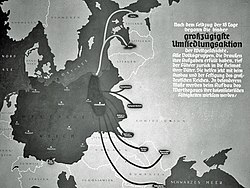
By 1942, Hitler's empire encompassed much of Europe, but the territories annexed lacked population desired by the Nazis.[41] After Germany had acquired her Lebensraum, she now needed to populate these lands according to Nazi ideology and racial principles.[41] This was to be accomplished before the end of the war by a "reordering of ethnographical relations".[41] The initial step of this project had already been taken by Hitler on 7 October 1939, when Himmler was named the Reich Commissar for the Consolidation of Germandom (Reichskommissar für die Festigung deutschen Volkstums) (RKFDV) (see also Hauptamt Volksdeutsche Mittelstelle, VoMi)[41] This position authorized Himmler to repatriate ethnic Germans (Volksdeutsche) living abroad to occupied Poland.[41] Himmler's jurisdiction as the guardian of the Volksdeutsche re-settlement efforts was increased to other occupied territories to be Germanized as the war continued. To make room for the German settlers, hundreds of thousands of Poles and French living in these lands were transferred across borders.[42] The great majority of Himmler's Volksdeutsche were acquired from the Soviet sphere of interest under the German–Soviet "population exchange" treaty.[42]

At the end of 1942 a total of 629,000 Volksdeutsche had been re-settled, and preparations for the transfer of 393,000 others were underway.[42] The long-term goal of the VoMi was the resettlement of a further 5.4 million Volksdeutsche, mainly from Transylvania, Banat, France, Hungary and Romania.[42] The immigrants were classified either as racially or politically unreliable (settled in Altreich), of high quality (settled in the annexed eastern territories) or suitable for transit camps.[42] Himmler encountered considerable difficulties with the Volksdeutsche of France and Luxembourg, who often wished to retain their former status as citizens of their respective countries.

